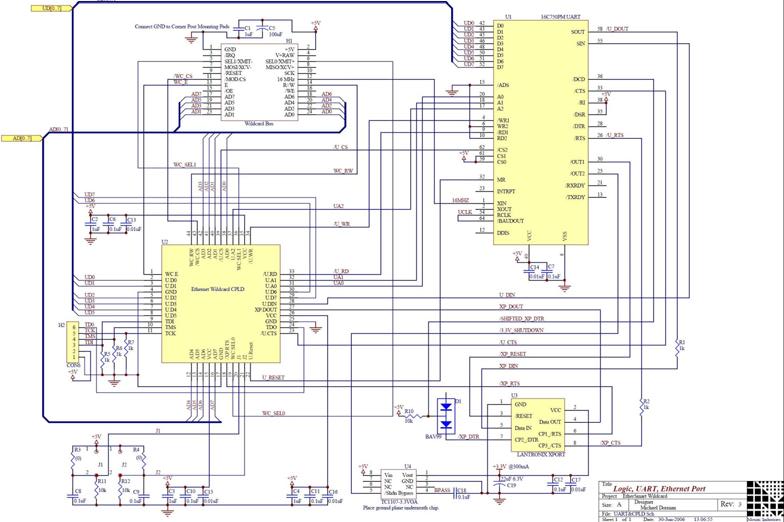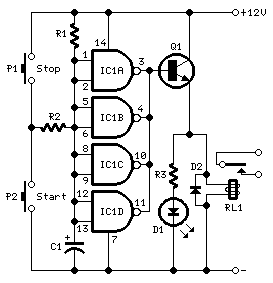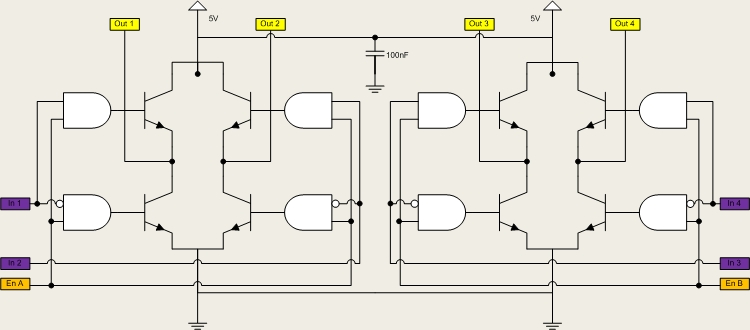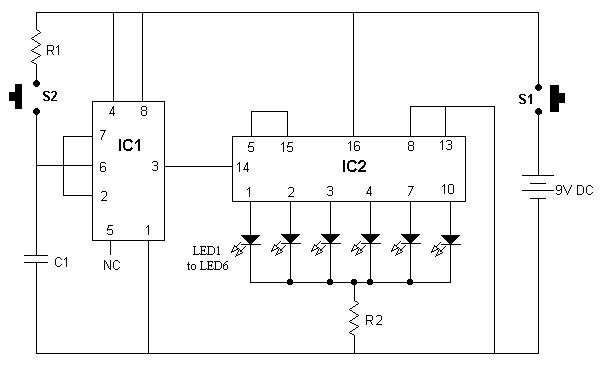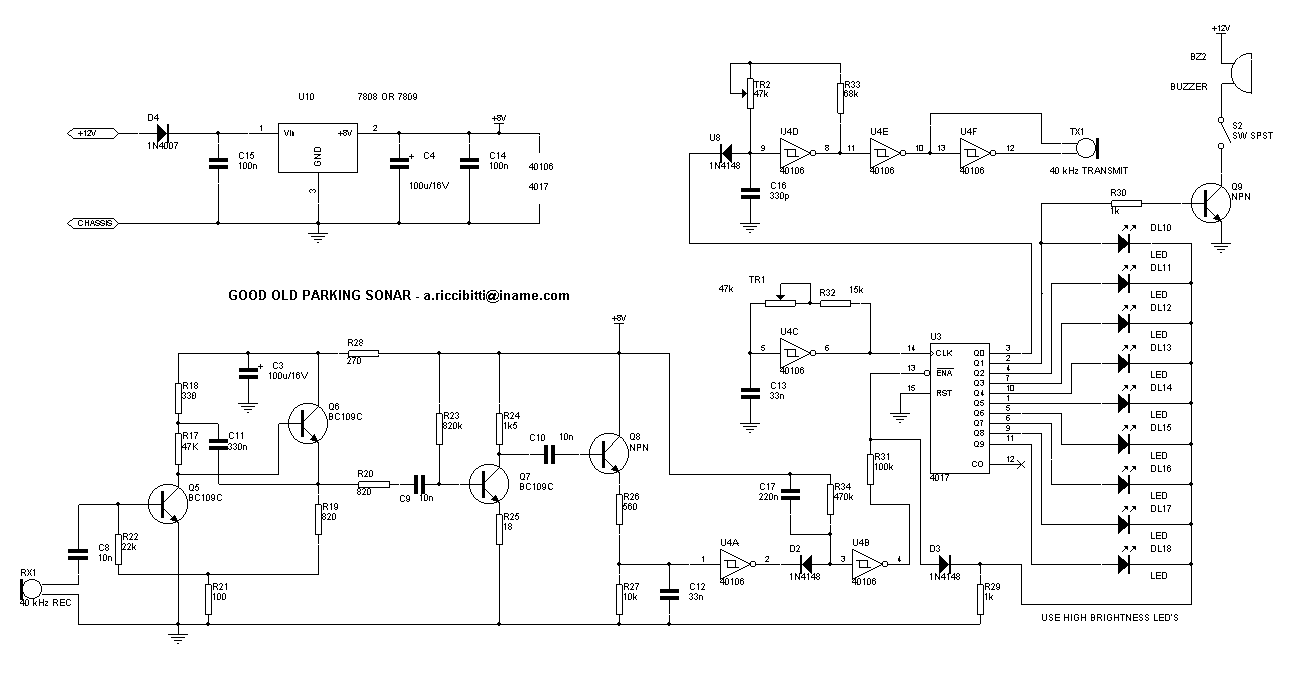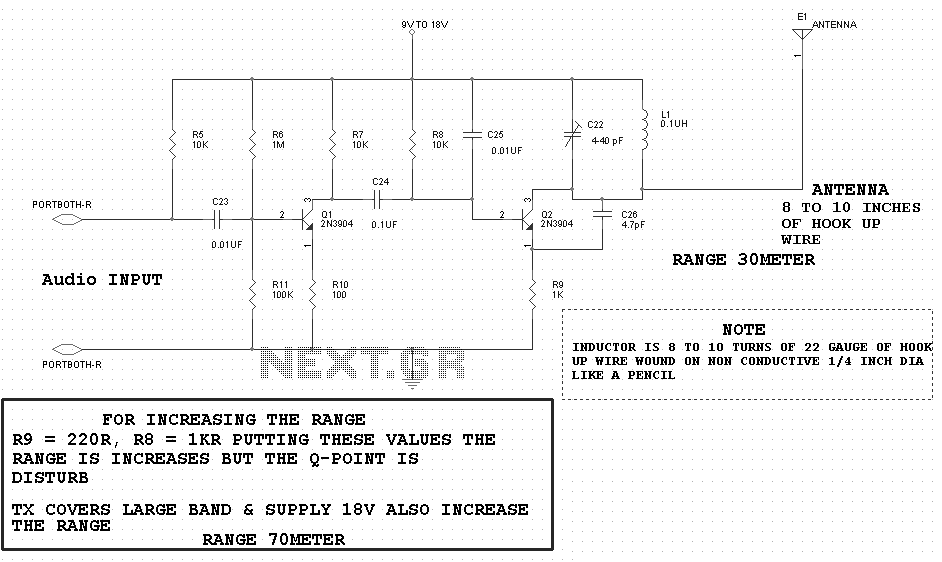
park aid schematics
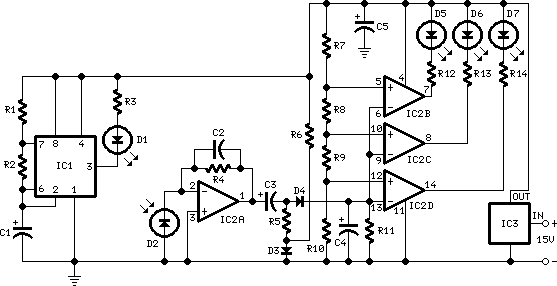
IC1 operates as an oscillator that drives an infrared LED with pulses of 0.8 milliseconds at a frequency of 120 Hz, generating approximately 300 mA of peak current. Diodes D1 and D2 are aligned and positioned a few centimeters apart on a short breadboard strip secured to a wall. D2 receives the infrared beam emitted by D1, which is reflected by a surface in front of it. The signal is amplified by IC2A and peak detected using D4 and C4. Diode D3, along with resistors R5 and R6, compensates for the forward voltage drop of D4. A DC voltage that corresponds to the distance between the reflecting object and D1/D2 is fed into the inverting inputs of three voltage comparators. These comparators control the switching of the LEDs based on voltages at their non-inverting inputs, which are established by a voltage divider formed by resistors R7 to R10. A regulated power supply is necessary, which is why IC3 is included for accurate reference voltages. The circuit can be powered by a commercial wall plug adapter with a DC output voltage ranging from 12 to 24 volts. The infrared photodiode D2 should include an optical sunlight filter and is typically housed in a black plastic casing, resembling TO-92 transistors; it is essential to note that the sensitive area is the curved surface rather than the flat one. It is advisable to house all components close to the infrared LEDs in a compact enclosure. The three signaling LEDs can be positioned away from the main enclosure at a height that ensures visibility for the car driver. The optimal configuration is achieved by bringing D2 close to D1 (without a reflecting object) until D5 lights up, then slightly adjusting the distance until D5 turns off. Generally, the ideal distance between D1 and D2 is between 1.5 and 3 cm.
IC1 functions as a key component in generating a consistent pulse signal that drives the infrared LED (D1). The 0.8 ms pulse duration at a frequency of 120 Hz ensures that the LED emits infrared light intermittently, allowing for effective distance measurement when the light is reflected back to the photodiode (D2). The arrangement of D1 and D2 is critical; they must be precisely aligned to maximize the detection of the reflected infrared signal.
The amplification stage, which includes IC2A, enhances the weak signal received by D2, ensuring that even minor reflections can be detected. The peak detection circuit formed by D4 and C4 is essential for converting the amplified signal into a usable DC voltage that correlates with the distance of the reflecting object. The compensatory action of D3 with resistors R5 and R6 is vital for maintaining accuracy by accounting for any voltage drops that may occur across D4, ensuring that the voltage readings remain reliable.
The voltage comparators play a crucial role in the circuit's functionality, as they compare the processed voltage with predetermined reference levels set by the voltage divider network (R7-R10). This comparison determines when to activate or deactivate the signaling LEDs, allowing for a visual indication of the distance measured. The use of a regulated power supply via IC3 is necessary to prevent fluctuations that could affect the reference voltages and, consequently, the performance of the comparators.
For optimal performance, the infrared photodiode D2 should be selected carefully to include a sunlight filter, ensuring it only responds to the infrared light emitted by D1. The physical arrangement of the components is also significant; housing the circuitry close to the LEDs minimizes interference and enhances signal integrity. The signaling LEDs, which provide visual feedback to the user, should be positioned at a height that ensures they are easily visible to a driver, facilitating effective operation of the system. The tuning process for D1 and D2 is straightforward and involves adjusting their distance until the desired sensitivity is achieved, with the typical effective range being between 1.5 and 3 cm.IC1 forms an oscillator driving the infra-red LED by means of 0. 8mSec. pulses at 120Hz frequency and about 300mA peak current. D1 & D2 are placed facing the car on the same line, a couple of centimeters apart, on a short breadboard strip fastened to the wall. D2 picks-up the infra-red beam generated by D1 and reflected by the surface placed in fro nt of it. The signal is amplified by IC2A and peak detected by D4 & C4. Diode D3, with R5 & R6, compensates for the forward diode drop of D4. A DC voltage proportional to the distance of the reflecting object and D1 & D2 feeds the inverting inputs of three voltage comparators. These comparators switch on and off the LEDs, referring to voltages at their non-inverting inputs set by the voltage divider resistor chain R7-R10.
Power supply must be regulated (hence the use of IC3) for precise reference voltages. The circuit can be fed by a commercial wall plug-in adapter, having a DC output voltage in the range 12-24V. The infra-red Photo Diode D2, should be of the type incorporating an optical sunlight filter: these components appear in black plastic cases.
Some of them resemble TO92 transistors: in this case, please note that the sensitive surface is the curved, not the flat one. It is wiser to place all the circuitry near the infra-red LEDs in a small box. The 3 signaling LEDs can be placed far from the main box at an height making them well visible by the car driver.
The best setup is obtained bringing D2 nearer to D1 (without a reflecting object) until D5 illuminates; then moving it a bit until D5 is clearly off. Usually D1-D2 optimum distance lies in the range 1. 5-3 cm. 🔗 External reference
IC1 functions as a key component in generating a consistent pulse signal that drives the infrared LED (D1). The 0.8 ms pulse duration at a frequency of 120 Hz ensures that the LED emits infrared light intermittently, allowing for effective distance measurement when the light is reflected back to the photodiode (D2). The arrangement of D1 and D2 is critical; they must be precisely aligned to maximize the detection of the reflected infrared signal.
The amplification stage, which includes IC2A, enhances the weak signal received by D2, ensuring that even minor reflections can be detected. The peak detection circuit formed by D4 and C4 is essential for converting the amplified signal into a usable DC voltage that correlates with the distance of the reflecting object. The compensatory action of D3 with resistors R5 and R6 is vital for maintaining accuracy by accounting for any voltage drops that may occur across D4, ensuring that the voltage readings remain reliable.
The voltage comparators play a crucial role in the circuit's functionality, as they compare the processed voltage with predetermined reference levels set by the voltage divider network (R7-R10). This comparison determines when to activate or deactivate the signaling LEDs, allowing for a visual indication of the distance measured. The use of a regulated power supply via IC3 is necessary to prevent fluctuations that could affect the reference voltages and, consequently, the performance of the comparators.
For optimal performance, the infrared photodiode D2 should be selected carefully to include a sunlight filter, ensuring it only responds to the infrared light emitted by D1. The physical arrangement of the components is also significant; housing the circuitry close to the LEDs minimizes interference and enhances signal integrity. The signaling LEDs, which provide visual feedback to the user, should be positioned at a height that ensures they are easily visible to a driver, facilitating effective operation of the system. The tuning process for D1 and D2 is straightforward and involves adjusting their distance until the desired sensitivity is achieved, with the typical effective range being between 1.5 and 3 cm.IC1 forms an oscillator driving the infra-red LED by means of 0. 8mSec. pulses at 120Hz frequency and about 300mA peak current. D1 & D2 are placed facing the car on the same line, a couple of centimeters apart, on a short breadboard strip fastened to the wall. D2 picks-up the infra-red beam generated by D1 and reflected by the surface placed in fro nt of it. The signal is amplified by IC2A and peak detected by D4 & C4. Diode D3, with R5 & R6, compensates for the forward diode drop of D4. A DC voltage proportional to the distance of the reflecting object and D1 & D2 feeds the inverting inputs of three voltage comparators. These comparators switch on and off the LEDs, referring to voltages at their non-inverting inputs set by the voltage divider resistor chain R7-R10.
Power supply must be regulated (hence the use of IC3) for precise reference voltages. The circuit can be fed by a commercial wall plug-in adapter, having a DC output voltage in the range 12-24V. The infra-red Photo Diode D2, should be of the type incorporating an optical sunlight filter: these components appear in black plastic cases.
Some of them resemble TO92 transistors: in this case, please note that the sensitive surface is the curved, not the flat one. It is wiser to place all the circuitry near the infra-red LEDs in a small box. The 3 signaling LEDs can be placed far from the main box at an height making them well visible by the car driver.
The best setup is obtained bringing D2 nearer to D1 (without a reflecting object) until D5 illuminates; then moving it a bit until D5 is clearly off. Usually D1-D2 optimum distance lies in the range 1. 5-3 cm. 🔗 External reference
